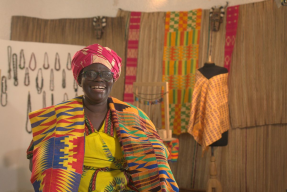
By Rob Packer, KF10 Colombia
When I first became a Kiva Fellow, I never imagined that one day I’d spend a cold, rainy afternoon in Bogotá discussing the merits of art-as-expression against art-for-profit with an aspiring artist and Kiva borrower.
The Nevera (the fridge as Bogotá is known to costeños for its chilly climate) has a very feel from Colombia’s Caribbean coast where I’m based. Partly this is because you need a coat and an umbrella; but it’s mainly because of Bogotá’s urban charm, which sometimes reminds me of European cities like Madrid; and the more formal and reserved nature of the cachacos (people from the interior of Colombia). Bogotá is also a city of revolutionary urban projects, such as Ciclovía—other cities might boast at closing their streets on Sunday mornings so inhabitants can go cycling or running, but the roots of this began in Bogotá 30 years ago—and the TransMilenio, the urban transportation system of running buses in dedicated lanes—admittedly Curitiba was the pioneer, but Bogotá’s version is often cited as the model when yet another Latin American city opens a network. As the capital, it’s also a national centre of art and on a previous trip to Bogotá some Colombian friends had shown me around La Macarena, a bohemian barrio of the city admiring the street art and imaginative restaurant concepts.
On my next trip one of Bogotá’s credit officers, Luis Carlos, and I headed to the south of the city to visit Germán Gustavo Garzón, a self-taught and aspiring artist as well as Kiva borrower, who lives in a barrio called La Macarena de los Alpes: like its namesake it’s perched on the side of the escarpment overlooking Bogotá, but lies at quite a different end of the socioeconomic scale. As we arrived at the point on the hillside where Bogotá ends and the mountains begin and the rain began to fall, I was struck by how unexpected the situation was: I’ve realized I’m far more used to meeting artisans than artists (for more on the difference in perspective, check out Suzy Marinkovich’s 2009 post on the same topic in Peru).
Germán’s parents moved from the countryside to Bogotá many years ago and began setting up businesses very similar to the microbusinesses that I see on a daily basis: his father worked as a shopkeeper, his mother as a seamstress. Germán told us that “A muchos de los papás de mis amigos era impensable que su hijo pueda ser pintor, o poeta (To a lot of my friends’ parents, it was unthinkable that their son should become a painter or a poet).” As if to express the irony of this view, all of their children developed an artistic streak of one kind of another; Germán told us that during his childhood, the house would be dominated by his two sisters dancing on the staircase—both are now contemporary dance and performance art teachers—while Germán painted and his brother wrote poems and short stories on a typewriter. For much of his childhood and adolescence, he had no formal artistic training and only started taking courses in the past few years. It was at a woodwork class at the Escuela de Artes y Oficios—an organization with links to FMSD—where he attended an information session with two Bogotá credit officers and became a borrower with FMSD.
In my experience of microfinance, it can often be difficult to support a family member in their dreams as an artist: I have come to learn that it’s an incredible luxury for a Kiva borrower’s child to attend music or ballet classes and a sign that their business is going well. Germán’s response to these needs has been to bridge the gap between microentrepreneur, artist and artisan, and to do both: he used his first loan to invest in materials, which he uses to create artisan works (art-for-profit) and it’s the proceeds from these artesanías that then support him in his true passion, art-as-expression, either as work for friends, for art shows or socially-minded projects such as murals in the local community or performance art with marginalized groups in Colombian society.
As the conversation continued to a rainstorm and background music from Beirut, Sigur Rós and Björk against a view over southern Bogotá, adding to the magic, it emerged that both Luis Carlos and I were frustrated artists—he a painter or sculptor, I a photographer or writer—beaten as we both became to realize that art wasn’t for us.

Germán as artist. This painting representing his grandmother was one of his first paintings and was what made his realize he should follow the path towards becoming an artist.
Meeting people like Germán is one of the most rewarding parts of being a Kiva Fellow. It makes you realize that in spite of the difficulties that borrowers might experience, sometimes vocation is vocation. It made me thankful to know that microfinance provides people like him with the means to pursue their dreams.
Rob Packer is a Kiva Fellow currently working with the Fundación Mario Santo Domingo in Barranquilla, Colombia. There are borrowers from Colombia with FMSD who you can help by contributing to a loan today, and many other entrepreneurs from around the world on the Kiva site.


















